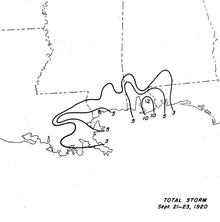1920 Louisiana hurricane
 Surface weather analysis of the storm on September 21 | |
| Meteorological history | |
|---|---|
| Formed | September 16, 1920 |
| Dissipated | September 23, 1920 |
| Category 2 hurricane | |
| 1-minute sustained (SSHWS/NWS) | |
| Highest winds | 100 mph (155 km/h) |
| Lowest pressure | 975 mbar (hPa); 28.79 inHg |
| Overall effects | |
| Fatalities | 1 |
| Damage | $1.45 million (1920 USD) |
| Areas affected | Jamaica, Cuba, Louisiana and Texas |
| IBTrACS | |
Part of the 1920 Atlantic hurricane season | |
The 1920 Louisiana hurricane was a strong
landfall near Houma, Louisiana with no change in intensity. Afterwards, it quickly weakened over land, before dissipating on September 23 over eastern Kansas
.
As it approached the
railroads, leading to several rail accidents. Across the Gulf Coast, damage from the storm totaled to $1.45 million,[nb 1]
and one death was associated with the hurricane.
Meteorological history

Map key
Tropical depression (≤38 mph, ≤62 km/h)
Tropical storm (39–73 mph, 63–118 km/h)
Category 1 (74–95 mph, 119–153 km/h)
Category 2 (96–110 mph, 154–177 km/h)
Category 3 (111–129 mph, 178–208 km/h)
Category 4 (130–156 mph, 209–251 km/h)
Category 5 (≥157 mph, ≥252 km/h)
Unknown
Tropical storm (39–73 mph, 63–118 km/h)
Category 1 (74–95 mph, 119–153 km/h)
Category 2 (96–110 mph, 154–177 km/h)
Category 3 (111–129 mph, 178–208 km/h)
Category 4 (130–156 mph, 209–251 km/h)
Category 5 (≥157 mph, ≥252 km/h)
Unknown
Storm type
In mid-September, a
barometric pressure below 1,005 mbar (29.7 inHg).[1] The weak disturbance later made landfall at that intensity on the Mosquito Coast near the border of Honduras and Nicaragua by 0600 UTC on September 18. The small system gained intensity as it moved over Honduras, attaining tropical storm strength on September 19 prior to entering the Gulf of Honduras near Trujillo.[1][2] In the Gulf of Honduras, the tropical storm slightly intensified to maximum sustained winds of 50 mph (80 km/h) on September 20, and later made landfall on the Yucatán Peninsula as it accelerated towards the north-northwest.[2] Despite initially being reported to have maintained intensity across the peninsula, a reanalysis of the storm determined that it had weakened to minimal tropical storm strength, before entering the Gulf of Mexico late on September 20.[1]
The weakened tropical storm began to intensify once in the Gulf of Mexico. On September 20 at 0600 UTC, the storm reached hurricane intensity as a modern-day
landfall at peak intensity near Houma, Louisiana at 0100 UTC later that day. Maximum winds spanned 32 mi (51 km) from the center at landfall. Ships offshore the Louisiana coast also reported an eye associated with the hurricane. Once over land, the system began to quickly weaken, degenerating to tropical storm strength by 0600 UTC the same day,[2] while located near Iberville Parish.[3] Continuing to accelerate towards the north-northwest, it is estimated that the tropical cyclone dissipated on September 23 over Kansas, based on observations from nearby weather stations.[1]
Preparations and impact

oil fields in advance of the hurricane.[10] People along Lake Pontchartrain evacuated into New Orleans, causing hotels to overflow and forcing refugees to take shelter in other public buildings including post offices.[11]
Strong winds and gusts were reported across the Gulf Coast and in the Gulf of Mexico. A ship reported a minimum central barometric pressure of 999 mbar (29.5 inHg) just prior to the storm's intensification into a hurricane.sugar cane, totaled to $700,000.[1]
See also
Notes
- ^ All damage totals are in 1920 United States dollars unless otherwise noted.
References
- ^ a b c d e f g h i Landsea, Chris; et al. "Documentation of Atlantic Tropical Cyclones Changes in HURDAT". United States National Oceanic and Atmospheric Administration. Retrieved January 16, 2013.
- ^ a b c d e "Atlantic hurricane best track (HURDAT version 2)" (Database). United States National Hurricane Center. April 5, 2023. Retrieved April 20, 2024.
 This article incorporates text from this source, which is in the public domain.
This article incorporates text from this source, which is in the public domain.
- ^ . Retrieved January 16, 2013.
- ^ a b c "Great Hurricane Nears Gulf Coast; Coming Up From Yucatan Peninsula". The Washington Reporter. New Orleans, Louisiana. United Press International. September 21, 1920. p. 1. Retrieved January 16, 2013.
- ^ "Gulf People Flee Before Hurricane" (PDF). New York Times. Washington, D.C. September 21, 1920. Retrieved January 17, 2013.
- ^ "Hurricane Nears Texas Coast". The Washington Reporter. Houston, Texas. September 21, 1920. pp. 1, 10. Retrieved January 16, 2013.
- ^ a b "Ready to Move Inhabitants". The Washington Reporter. Galveston, Texas. September 21, 1920. p. 10. Retrieved January 16, 2013.
- ^ a b "4,500 Move Out of Galveston" (PDF). New York Times. Galveston, Texas. September 21, 1920. Retrieved January 17, 2013.
- ^ "Weather Bureau Acts". The Washington Reporter. Washington, D.C. September 21, 1920. p. 10. Retrieved January 16, 2013.
- ^ "To Move Residents Off Island" (PDF). New York Times. Houston, Texas. September 21, 1920. Retrieved January 17, 2013.
- ^ a b "Small Damage Has Been Done by Hurricane". The Evening Independent. New Orleans, Louisiana. September 22, 1920. p. 10. Retrieved January 18, 2013.
- ^ a b c Roth, David M; Hydrometeorological Prediction Center. Louisiana Hurricane History (PDF). United States National Oceanic and Atmospheric Administration's National Weather Service. Retrieved January 18, 2013.
- ^ "Morgan City, in Main Path, Not Heard From". The Evening Independent. Washington, D.C. September 22, 1920. p. 1. Retrieved January 18, 2013.
- ^ Schoner, R.W.; Molansky, S. "Rainfall Associated With Hurricanes (And Other Tropical Disturbances)" (PDF). United States Weather Bureau's National Hurricane Research Project. p. 63. Retrieved January 18, 2013.
- ^ "Great Hurricane is Sweeping the Atlantic Coast". Greensburg Daily Tribune. Galveston, Texas; New Orleans, Louisiana. September 22, 1920. p. 1. Retrieved January 18, 2013.
